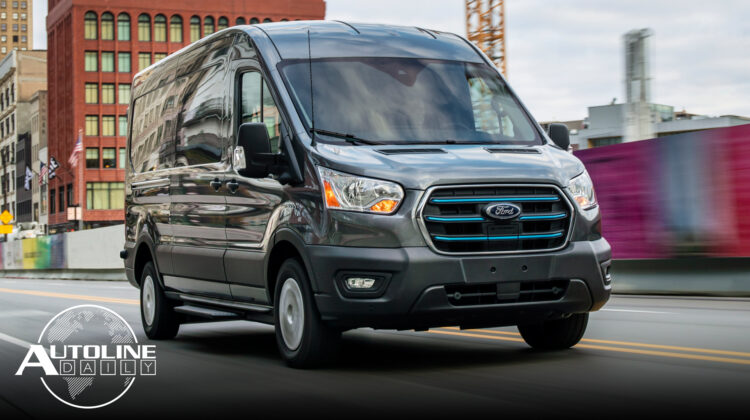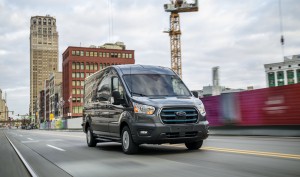
Listen to “AD #2959 – Ford Unveils Electric Transit; Nissan Sues Ghosn For Millions; Volvo Takes Crash Tests to The Extreme” on Spreaker.
Follow us on social media:
Runtime: 10:26
0:19 Nissan Sues Ghosn For Millions
0:59 Indonesia In Talks with Tesla
2:00 Volvo Takes Crash Tests to The Extreme
3:42 Tula Boosts Electric Motor Efficiency
4:43 Ford Unveils Electric Transit
5:54 Analyst Predicts Cybertruck Will Outsell Competition
7:22 BMW CEO Wants to Strengthen Toyota Partnership
8:07 New Bronco Optimized for Camping
8:56 VW Creates Colorful Beetle Out of Millions of Beads
Visit our sponsors to thank them for their support of Autoline Daily: Bridgestone, Hyundai and Intrepid Control Systems.
This is Autoline Daily, the show dedicated to enthusiasts of the global automotive industry.
Welcome to Friday the 13th. Normally we refer to this as an unlucky day. But remember, this is 2020. So this Friday the 13th will probably be the luckiest of the year.
NISSAN SUES GHOSN FOR MILLIONS
But not for Carlos Ghosn. He may have escaped from the police in Japan, but Nissan’s former CEO can’t escape the courts. Nissan is suing him for $95 million in damages. It accuses Ghosn of hiding compensation he wasn’t supposed to get, of getting kickbacks from a car dealer in the Middle East and temporarily putting some of his own personal financial losses on Nissan’s books. Carlos Ghosn says Nissan plotted to get rid of him because it was afraid he was going to merge Nissan together with Renault. And it sure looks like we’re going to be reporting on this story for years.
INDONESIA IN TALKS WITH TESLA
Indonesia wants to become the world’s largest producer of electric vehicle batteries. In order to become an EV battery hub, the government is sending out a team next week to the U.S. and Japan to try and lure new business to the country. According to Reuters, that includes a meeting with high-level Tesla executives. Indonesia, which has the world’s largest nickel reserves, wants Tesla and other companies to invest in nickel processing as a way to cut costs. Elon Musk has said he is planning to offer a “giant contract for a long period of time” so long as the nickel is mined in an environmentally safe way. The Indonesian minister leading the effort says the country could make the supply chain for batteries environmentally friendly in the next 7 to 8 years through powering smelters with renewable energy. By doing so, he says Indonesia could start selling green EV batteries to Europe by 2030.
VOLVO TAKES CRASH TESTS TO THE EXTREME
Today’s cars feature more high-strength steel than in the past. That’s great for cutting weight from a vehicle but in an accident, it makes it more difficult for rescue workers to use the jaws of life to extract a person from a car to save their life. So to help rescuers develop new extraction techniques, Volvo is dropping vehicles from a crane 30 meters or about 100 feet in the air, to simulate an extremely violent crash. It may seem like overkill but the automaker says this simulation can’t be done in normal crash testing. Rescue workers typically train with vehicles from a scrapyard but they’re usually up to two decades old and not built like modern cars. Volvo is using new vehicles in its crash test, to help rescuers stay up to date with extraction techniques. Volvo is putting together a report of its test and will make it available to rescue workers around the world for free.
TULA BOOSTS ELECTRIC MOTOR EFFICIENCY
There’s a fascinating development reported by Wards Intelligence. You’ve heard of Skip Fire, right? That’s the technology from a company called Tula that provides dynamic cylinder deactivation, where, for example, a V8 can run on one cylinder when cruising at a steady speed. General Motors licensed the technology and markets it as Dynamic Fuel Management. GM only runs its V8s down to two cylinders, but claims it can boost fuel economy by more than 10%. Well now Tula is applying the same concept to electric motors. They call it “Pulsed Electric Motor Control” and it pulses energy to an electric motor to make it more efficient. Tula claims it can boost overall efficiency of a BEV by 2% which could allow an automaker to remove $400 worth of batteries, or get more driving range, or reduce the size of the electric motor. You can get more info from Wards Intelligence, but it is behind a paywall.
FORD UNVEILS ELECTRIC TRANSIT
Ford gave us more info about the electric version of its Transit van. The eTransit, as they call it, will be offered in 25 configurations in Europe and 8 in North America. That includes 3 roof heights, 3 lengths and a chassis cab or cutaway version. It’s powered by an electric motor that develops 266 horsepower, or 198 kilowatts, as well as 317-pound-feet-of-torque. Its 67-kWh battery will deliver 126 miles of range with the low roof version. It will come with a 2.4-kW generator to provide electric power for tools at work sites. To help convince fleets to buy the eTransit, Ford will offer an 8 year, 100,000-mile warranty on the EV powertrain. It says owners will have 40% lower maintenance costs over that time frame. European versions will be built in Otosan, Turkey, while North American versions will be made in Kansas City. When it goes on sale in late 2021, it will have a starting price just under $45,000.
ANALYST PREDICTS CYBERTRUCK WILL OUTSELL COMPETITION
On Autoline This Week the topic is electric pickup trucks. Warren Browne is an analyst who did a deep dive into how these trucks will sell. He’s not very optimistic, with one exception: Tesla’s Cybertruck. Here’s why he thinks the Cybertruck will outsell all the others.
“I don’t see the Cybertruck fitting that mold in terms of a wildcard. However, just like the original minivans, the demand for Cybertruck, given its price, assuming that Musk is accurate on its price, and he’s done nothing but lower his price since he’s gotten to the market, so you’ve got to take a look at that avenue, right? Given the Cybertrucks price it may generate volume just like the minivan did from outside the traditional segment. So my bandwidth on Cybertruck is very, very wide and they’re the highest volume entry in my forecast.”
Of course, you can watch that entire show, and it’s jam packed with great info on electric pickups, on our website or our YouTube channel.
BMW CEO WANTS TO STRENGTHEN TOYOTA PARTNERSHIP
Investing in future technologies requires huge sums of money being dedicated to those efforts. It’s one of the reasons we’re seeing so many companies joining forces and BMW’s CEO, Oliver Zipse says he’d like to strengthen its bonds with Toyota. The two obviously share a sports car platform for the Supra and Z4, but also currently collaborate on fuel cell cars. Zipse would like to see those efforts continue on beyond 2025. BMW is going to cut costs by slimming down its lineup, which will require a review of coupes, convertibles and roadsters. So, it’s not surprising to see the German automaker want to continue its partnership with Toyota on sports cars.
NEW BRONCO OPTIMIZED FOR CAMPING
We know Ford is going after Jeep’s off-road crown with the all-new Bronco and is looking for ways to set itself apart. One such area it focused on is off-road camping. So, it designed in as much interior space as it could. With the front seats forward, the rear seat folded down and the tailgate closed on a Bronco 4-door, there’s 6-feet 6-inches of space. An optional slide-out tailgate that comes next year extends that by more than a foot. Ford even carved out an additional 10-inches of elbow room from the door area to increase the interior width to 3-feet 7-inches. And for the ultimate star gazing experience, the Bronco 4-door is offered in a variety of removable tops.
VW CREATES COLORFUL BEETLE OUT OF MILLIONS OF BEADS
I have to admit I’m a sucker for vehicles with anything stuck, glued, painted or etched all over their bodies. Doesn’t matter if it’s pennies, stickers or tattooed on koi fish. So, you can bet I was geeked over this classic VW Beetle that features almost 2.3 million glass beads laid into geometric patterns and depicting animals and crops. The vehicle pays homage to an indigenous group from Mexico. It took a team of 8 artists from the group over 9,000 hours to apply the beads by hand, sticking them on with resin. The work is impeccable, it’s breathtaking and I’m in awe. I’m sure I could spend hours looking at it in person. When not on loan, the car is parked at a museum in Mexico City.
And with that we wrap up this week’s worth of shows. Thanks for watching and we hope to see you again on Monday.
Thanks to our partner for embedding Autoline Daily on its website: WardsAuto.com

John McElroy is an influential thought leader in the automotive industry. He is a journalist, lecturer, commentator and entrepreneur. He created “Autoline Daily,” the first industry webcast of industry news and analysis.










